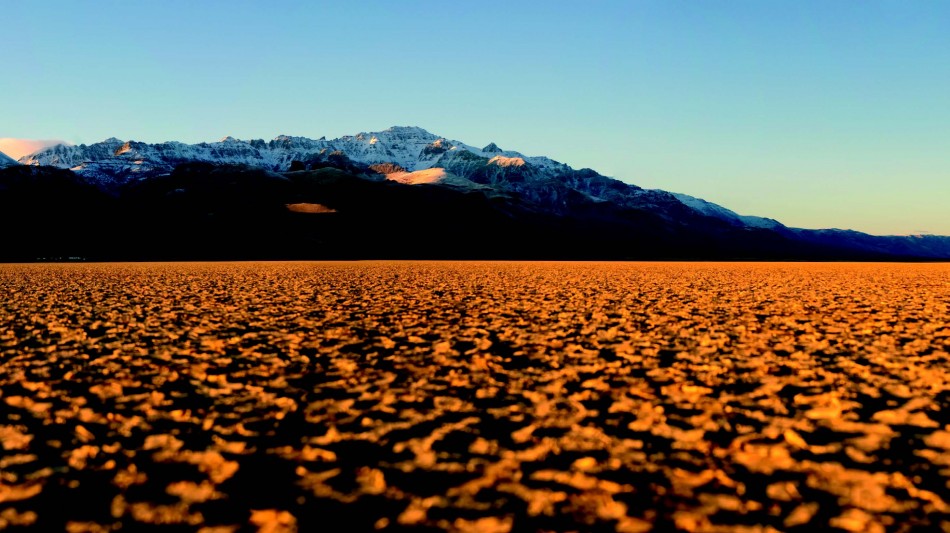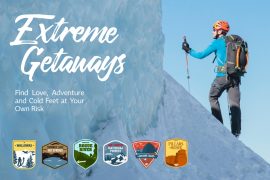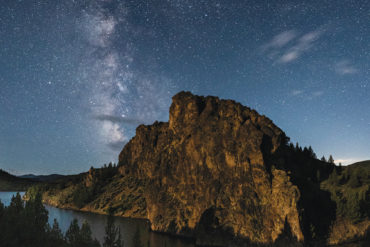The Steens Mountains are not what you think. To most drivers-by, The Steens appear to be an endless medley of sagebrush and volcanic basalt set into a desert scalp of blonde grasses. If you never set fool’s foot outside of your car, that description will play nicely.
Then there’s the subject-verb agreement problem with them, with it. Is it, “Steens Mountain is” or “The Steens are”? To not make them plural after undertaking a late summer four-day trek up and across one of the most varied and beautiful settings, is grammatical heresy. Like many things in the Pacific Northwest that take the name of a Hudson’s Bay Company fur trader or U.S. railroad or military attache, this mountain takes the name of Enoch Steen. Steen was a lieutenant colonel of the United States Army 1st Dragoons. Chasing off of its ancestral residents of the Paiute tribe earned Steen a mountain. Dragoons or not, the idea of a singular homogenized Steen breaks down the farther the foot-traveler gets into this fifty-mile-long microSteens ecology.
One person who knows the plurality of the Steens better than most is Brent Fenty, the 37-year-old director of the Oregon Natural Desert Association, or ONDA. Fenty has hiked in them, pulled fences in them, fished in them, camped in them and defended them against invasive species and corrosive legislation. He’s also the reason I’m going into them and the only chance I have of coming out of them alive.
No one would argue that there was a lot of arm-twisting before I agreed to go. The sophisticated psychological tactics that Fenty deployed were likely rehearsed before a team of experts across many disciplines before being distilled into this nugget of innocence: “Hey, I’m going to hike from Fields to Frenchglen over Steens Mountain. Do you want to go?”
If all goes well, we will have taken photos, video and general inventory of a forty-mile segment of a proposed 700-mile Oregon Desert Trail that starts in Bend and follows the shape of two udders through Plush and Fields before turning north into the Jordan Valley ending at Lake Owyhee State Park.
Day One
Into Wildhorse Canyon
Any excuse to sit down at Fields Station for a half-pound burger and a one-liter shake is probably a good one. Find a new trainer/doctor if they counsel to the contrary. If you’re working outside in 90 degree heat, driving to Las Vegas or if you think this is your last meal, all are equal atonement for the Fieldsburger. Still the lunch counter is too close to the Alvord Desert, where our first ascent awaits.
The Alvord Desert, like Steens Mountain, is a misnomer. Naturalists probably gave it the desert moniker to scare away others and keep it for themselves. This desert is the kind that’s built around a big lake with lots of water in it. To be fair, the lake is shallow and rests on top of an enormous white sandbar, a tidepool that a prehistoric sea long ago forgot to take back. When it’s a bone-dry year, the flat lake bed becomes a playground for sailboats with wheels and for land speed records, such as the one Kitty O’Neill laid down in 1976 at 512 miles an hour.
As you start the climb into the Steens, you can appreciate the twelve-mile-long runway, the water’s reflection of Pueblo Mountain and the lunch you just ate. We loaded our packs with food and fly-rods and when most hikers “set off for …,” my companion bolted like a snakebitten colt up the eastern flank of the mountain. One minute later, I was lagging and overheating, a trust we would honor for days to come.
Suddenly Fenty stopped and spun on his heels. “A leopard lizard!” A six-inch spotted lizard disappeared into the underbrush. “You don’t see them that often.”
We made quick work of a steep Jeep trail, caught our breath and cut north to begin our first side-hill traverse. The terrain was a sea of sagebrush with an undercurrent of chunky rocks. Below us, the Alvord Desert became yet more beautiful yet no more desert-like in the distance. Beneath us, our feet were stinging, smearing off the angles of heated sauna rocks.
Packing lightly for the unknown is a challenge. Every potential item has a consequence in its presence and in its omission. Weight and bulk are the existential challenge. Leaving behind a package of feral bacon can be devastating, too. Two nights before the trip, I had laid out the essentials: a pair of trail shoes, a survival knife with flint, a water bladder, a sleeping bag and biv sack, hiking poles, twelve bars dense with protein, nuts, powdered Gatorade, a fly-rod, a pair of shorts, an extravagance of three shirts including one cotton for the novelty, socks, sun block, bug repellent and some other food.
The most essential gear when bushwhacking through the high desert is your shoes. Must protect your feet at all costs. A critical part of that defense are ankle desert gaiters. You may look like you’re the errant member of a rural marching band who hit the desert and kept going, but gaiters keep your shoes from filling with sediment. A few days before the trip, Fenty told me to pick up some gaiters at REI, if I didn’t already have them. I didn’t, so I did, though it sounded a bit dramatic at the time. Deep into the first slog, they were holding up and preventing frequent stops for shoe dumps.
Within the first few hours of hiking, we had jumped a leopard lizard, and coveys of quail and chukar, an upland bird known for its ability to make ordinary tacos extraordinary. As fast a pace as Fenty marched, he tirelessly identified reptiles, birds and plants for my edification. Once, when I thought he was striding so fast that his intent was to leave me at the mercy of these reptiles, birds and plants, he suddenly stooped over the black basalt and pulled a small stone from a narrow crack in the terrain.
“An arrowhead!” he proclaimed. “It looks like someone’s worked it,” he observed of its broken top and sped off.
It was better than 85 degrees, nearly 4:30 and we had gained our first ridge of The Steens. From this lesser summit, we could look down into Wildhorse Canyon, our next objective. Yonder, Fenty assured me, lay the Wildhorse Creek with real water!
As daylight faded and as we dropped deeper into the canyon, the ecology changed. At one point, as I stood catching my breath, I was surrounded by deep wet greens of wild rose and cottonwoods. Wildhorse Creek bubbled through dense underbrush. If I had been blindfolded and led to this point by an ironic faction of eco-terrorists, I would have sworn that they had taken me into the tropical Hawaiian Pools of Oheo.
In five and a half hours, we had found joyous water in the Wildhorse Creek, flowing with such strength and through so much green that it was oblivious to the fact that this was a dry ol’ desert. Steens Mountain was inching toward plurality even as we pitched our sleeping bags, and cooked two steaks and mashed potatoes over a propane flame.
Day Two
Into the Little Blitzen
I packed a few hours of sleep into the ten seconds my eyes were closed. Breakfast was oatmeal with cranberries, hazelnuts and brown sugar. An unspeakable delight that travels well with Advil.
We packed up and set off north up the creek. If there were no Enoch Steen, the area’s Paiute name, Tse Tse-ede meaning “The Cold One,” could have survived Manifest Destiny. From where we stood alongside the Wildhorse Creek in Wildhorse Canyon, we longed for a cold one.
Day two would be the second-most challenging of our four-day excursion. We climbed Wildhorse Creek, most of it before the sun overcame the canyon. Near the top of this route, we could boot west over a saddle and into Little Blitzen Canyon, or track north for the high alpine Wildhorse Lake. Later, we traversed the ridge of Steens Mountain and punched through The Cold One’s snowfield, down through a wilderness water park and into the Little Blitzen Canyon. In day two, we would do about 5,000 vertical feet.
The race Fenty was in didn’t seem to account for the challenge ahead, pace without pacing. Pace, I always thought, implied restraint, as in “Pace yourself, Kevin! There’s plenty more, if you eat that.” We pushed through alder, willow, cottonwood, wild roses and currant at pace.
In the flower department, there was lupine, elephant’s head, mariposa lilies, penstemon, paintbrush, wild onions, aster, gentian and, Fenty spasmed, “Monkshood!” a beautiful purple flower shaped like a helmet of a Roman soldier. Like all things inside or outside of wilderness, the more beautiful, the more lethal. If this flower would have grazed our bushwhacked shins in the wrong way and found its way into our bushwhacked legs and up to our bushwhacked hearts, it could have reduced our blistering progress to permanent stasis.
Up we went, though, following the creek’s spectacular waterfalls and through wildflower beds galore. At noon, we popped over a ridge and encountered Wildhorse Lake. At nearly 8,400 feet and 90 degrees in the middle of August, patches of snow still clung to its banks, as if trucked in as part of a massive public works project. With dimensions of 1,200 feet long by 800 feet wide, Wildhorse Lake stood out like a big ol’ aqueous oddity in a tub made of porous basalt.
Two flower-mongers in their sixties had hiked down the steep trail from the Steens Mountain Loop and lingered along the rim of the lake. They must have been as impressed with this oasis as we were, for their hike back up to the rim and parking lot would be a steep one. We honed in on a sandy beach, stripped to the bug-bitten, bushwhacken flesh and jumped into the glacial waters. Ten seconds go by slowly when you’re bathing in ice water.
Dropping into the Little Blitzen Canyon is perhaps the most challenging counterpoint to the argument of this assertion of desert. The Steens Mountain snowfield rolls over its rim and dissolves into a million rivulets with tropical cabbages that double as solid footholds on steep descents. At the base is a field of flowers that rivals any I’ve seen on the wetter side of the Cascades.
Farther along down the Little Blitzen, just below a falls and a pool, we dropped our packs, took out our fly-rods and cast into the shadows.
Preparation is everything. The day before the trip, I had walked into a fly-fishing outfitter, laid my rod and reel on the counter and asked a young store clerk how not to embarrass myself while deploying these. I quickly learned which end was for fishing and which was for reeling. The coordination part would have to be banged out in practice.
Within the first few casts into the Little Blitzen, I had caught my first victim—a 20-pound redside rosebush on a new grasshopper fly. My well-angled companion caught and released two Redband trout not big enough for our appetites.
That night, Fenty pulled from his pack two welcome guests: bacon and whiskey. His flask reminded me that I had forgotten mine. The whiskey made it easier to forget that I had forgotten long pants and that the brittle underbrush had carved a Jackson Pollock into my legs.
Bacon is a salve that, taken orally, is known to alleviate symptoms from bug bites to bubonic plague. Torn to pieces and folded into mac n cheese, it made for a filling end to an arduous day. We didn’t know that the toughest leg of the trip lay in ambush just over night’s dark horizon.
Day Three
Into the Blitzen
On this day, the sun rose early and furnaced itself to 90-some degrees by the time it hit the unshaded stretch of the Blitzen Crossing. This stretch was a fifteen-mile stomp along a so-called Jeep trail. After it was done, we’d plod more than eight hours through scorching heat to reach mother Blitzen, a body that collects most of the other bodies of water across several drainages in The Steens.
Early morning, the dark cool pools along the Little Blitzen were too fish-able to get an early start. My right hand and left leg began to swell from something that got into my sleeping bag that night. We had five tablets of benedryl, so I ate two.
As we trekked through the remaining thick bushes and trees along the Little Blitzen, Fenty again led out the attack. By now, I had realized that he was faster than me on the ascents, the descents, the flats, on side hills and pretty much any angle Earth and gravity would support.
Because of the rattlesnakes known to inhabit any of the thousands of bushes we were kicking into, I told him that I was happy with this pecking order. “Rattlers never bite the first one through,” he threw back at me. “It’s the second one that annoys them.”
Just before leaving the river canyon, Fenty’s hand shot up and slapped his right eye so loudly that his scream seemed of secondary import in his defense. Bees apparently don’t wait for the second hiker. A giant bee had just stung him in the right eyelid. It puffed out within seconds and we were now down to one benedryl tablet for the next day and a half.
Even with an eye and a half, Fenty seemed no slower as we strode into the hottest stretch of the trip. For our next trick, we had to cover ten miles of a rock-strewn Jeep trail to get to the Blitzen River in Cold Springs Canyon.
No Jeep ever built could have made it more than a mile on this trail without a mechanical concussion. The trail was overgrown with blonde hay and rocked with boulders. The rough provided no relief to the trail. We relied continually on our hiking poles for balance as our feet skidded this way and that over the side of rocks.
After a few hours, we pulled up for food in a small side canyon. I looked at my hand and my leg but said nothing about how large they had grown. For a while, it seemed the anti-inflammatory was getting the upper hand. Now the leg and the hand were gaining the upper hand. Fenty’s eyes followed mine.
“It’s about two and a half miles to the Steens Mountain Loop if we walk directly that way,” he said pointing west. “We can get out of here if we need to.”
I checked the temperature of both swollen areas and then my forehead for a fever caused by infection. Everything was hot, but only so hot as the day itself.
“I’m all in,” I said. “Let’s keep going.” Bravado starts and ends with binding phrases like these that you feel silly taking back later. So we went.
Fenty checked his GPS and said that we had only about five more miles to go. At our pace in this terrain, that meant a little more than two hours. We were conserving dwindling water supplies and eating along the way. For the first time this trip, I dumped Gatorade powder into my water, almost enough to caulk tile then cursed my wife for buying and packing the healthier less sugary G2.
According to the GPS gods, a couple miles ahead we would cross an “intermittent creek.” We shouldered our bags and melted back into the heat. Given the amount of snow we had this winter and the amount of water cascading down the Wildhorse and Little Blitzen canyons just a couple of drainages over, this creek was bound to be more mittent than the less fequent inter.
We plodded on quietly determined to make it to the mittent creek, controlling our energy levels and conserving our last sloshes of water. Ahead, at a treeline that denoted a creek, Fenty had stopped and was looking down. The creek! Merciful mittent creek!
“There’s not enough here.” Fenty was frowning at a series of small muddy puddles that came from the slope above him. We’d have to push on. Intermittently.
One foot in front of the other we went. Now we were in wilderness and just needed the next rivulet, the next creek, any trickle where we could pool the water then pump it into our bodies through a filtering device. We pushed on with the relentlessness of junkies in search of a fix, our water bottles boiling in the heat.
After five hours, the terrain began to soften and deepen. There were trees, and down a steep embankment lay the mighty Blitzen. Water! We took off our shoes and dipped our swollen feet in the river, got in it with clothes still on, and lay in it and filled our water bottles with it. Tomorrow would be a ceremonial hike to the finish line at Page Springs.
Dinner couldn’t come soon enough at our campsite along the Blitzen. Lasagna with meat. It’s amazing what boiling water can partially reconstitute in the wilderness.
I saved all of my sleeping for one night and this was it. There was a light breeze, the lullaby of the river and no menacing black flies nor mosquitos in the area. By 8:00, I was in a wilderness of sleep.
Day Four
Out of The Steens
Our spirits lifted knowing this was a short scramble across two rivers to Page Springs. The prior day had taken its toll on Fenty’s feet. He taped everything he could, and we de-camped. At least on that final day, I thought, I’d be able to keep pace with the debilitated version of him. Of course, he found that his wounds actually felt less worse if he quickened his pace to a jog. Oh joy.
Out of Cold Springs Canyon, across the Blitzen and out of the Steens we came … at a jog. Four days and forty miles from the Alvord Desert to outside of Frenchglen, we had ticked off an incredibly beautiful section of the proposed 700-mile Oregon Desert Trail. Though day three was classic desert, much of our desert trip was spent in some version of the tropics without humidity, surrounded by cascading water and too many flowers to name. The Steens were many, not one . They were not what I’d thought they’d be after driving past them en route to Las Vegas.
My dad often calls from his airy in Vermont with story ideas gleaned from books he’s read, Vermont Public Radio or his own contrivance. These ideas take the form of vast generalities that need only a little bit of work to Oregon-ize them for the magazine. “Do a piece on trappers,” he has blurted. “Do a thing on fire,” he’s demanded. “What about shepherds? Are there any shepherds left?” If the roles were reversed and I were the retired professor with gads of time and peaty scotch, I might call him and say, “You got mountains there, right? They run right down the middle of the damned state! Has anyone written anything about that? Smack down the middle of the state!”
One day a year ago, though, he was onto something and it couldn’t wait. Hello? “Yeah, I was just looking at a map.” Uh-huh. “Well, the southeastern part of the state looks to be a complete shite-hole. Get down there and check it out.”








